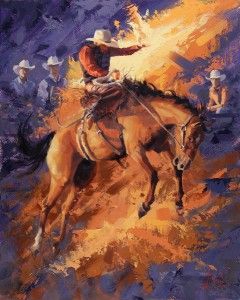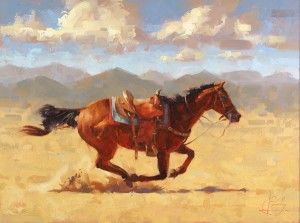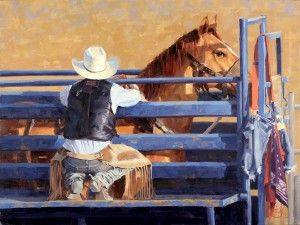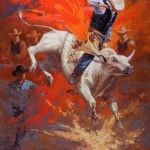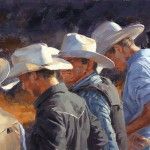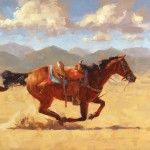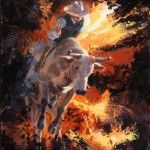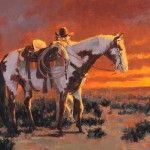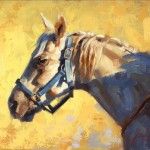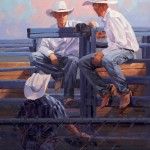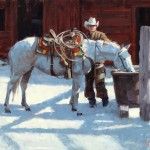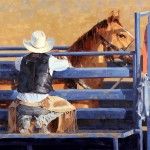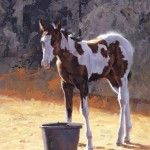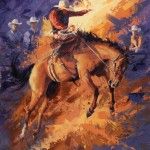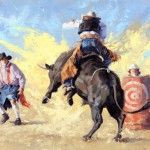Jim Connelly, Blazing Saddle, oil, 16 x 20.
Michigan artist Jim Connelly sees visual beauty in ranching life
By Gussie Fauntleroy
This story was featured in the March 2013 issue of Southwest Art magazine. Order the Southwest Art March 2013 print issue, or get the Southwest Art March 2013 digital download now…Or better yet, just subscribe to Southwest Art and never miss a story!
AT AGE 20, Jim Connelly thought he had everything he could want in life. He was living with a friend in the Ohio countryside. He had his own small business custom-painting vans, motorcycles, and cars. Nothing stood between him and the wild life he shared with other guys involved in street racing and cars. He was young, financially independent, and free to party every night of the week if he wanted to.
But he was miserable. And in his vague, indefinable misery, Connelly began to wonder what was missing in his life. He reflected on the religious doctrine he had picked up as a boy shuttling between his father’s Catholicism and his mother’s Methodist church. He was in the midst of pondering Christian beliefs when, suddenly, a more immediate question popped into his mind: What do people do who don’t get high? The answer to that question eventually transformed him from a partier to a follower of Jesus Christ to an illustrator and eventually to an award-winning cowboy artist firmly rooted in the Upper Midwest.
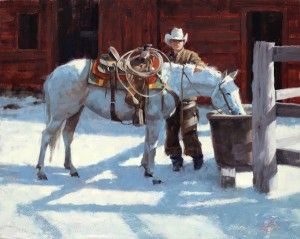
Jim Connelly, First Snow, oil, 16 x 20.
The first step in Connelly’s life-altering path took place when he decided to look for an answer at church, which had not been part of his life since he was 10 years old. Hearing of a friend who attended, he tagged along one Sunday and was amazed to find himself accepted and comfortable in a very different world. “Here I was, a freakish, hippie-type ’70s person, and old men were welcoming me. They invited me to breakfast. They started mentoring me,” the 55-year-old painter remembers, smiling, as he sits in the studio at his home in a small western Michigan town. Among his new church friends, the young man was inspired to find and pursue what he truly wanted to do with his life. What he truly wanted to do, of course, was art.
Born near Detroit and raised in Michigan and Ohio, Connelly still treasures a 1960s-era painting of roosters by his mother that hung in the kitchen of his boyhood home. Although he doesn’t remember watching her paint, he certainly absorbed at least the sense of creating art as a natural part of life. As a kid he was handy at making things with his hands, a skill that morphed into custom-painting bicycles and vehicles by the time he was 14 years old. Right out of high school he was hired by a dealership to airbrush murals on brand-new customized vans. While the dealership let him paint whatever he wanted, he was not yet ready to connect with the subject matter that would become his passion in art.
Jim Connelly, The Prodigal, oil, 12 x 16.
Visually expressing the positive, uplifting elements in life is central to his underlying spiritual view.
In his early 20s, Connelly earned a religion degree from Cornerstone University in Grand Rapids, MI. After meeting and marrying his wife, Rachel, he worked in freelance illustration for five years before enrolling in Syracuse University for a master’s degree in illustration. His knowledge of drawing and painting, prior to that, was almost entirely self-taught. The art teacher at his high school did not promote creative thinking and, in fact, discouraged Connelly from pursuing an interest in art. Once at Syracuse University, however, years of creative activity and inclination allowed him to immediately take advantage of what he was taught. The school’s illustration program included instruction from acclaimed professional artists based in San Francisco, Chicago, and New York. When one of these instructors began explaining about value, light, and shadow, a megawatt bulb lit up in the young man’s mind, completely changing his approach to art. “One of the reasons I went to Syracuse was that I wanted to paint certain things and didn’t understand why I couldn’t,” he recounts. “But everything has light and shadow. I realized, Oh! If you learn this, anything you look at, you can paint! That just blew the door open. It all came together—the drawing, the painting, and understanding how to make art. It all made sense.”
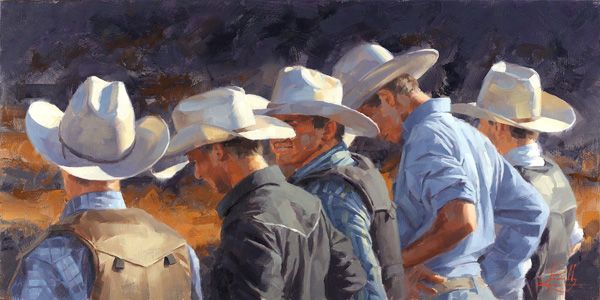
Jim Connelly, Usual Suspects, oil, 12 x 24.
While still a graduate student, Connelly was chosen to participate in The Artist and the Baseball Card, an exhibition of artists’ interpretations of classic baseball cards. As part of the show, his painting of Detroit Tigers pitcher Frank Tanana traveled to museums around the world, including the Norman Rockwell Museum, the Delaware Art Museum, and the National Baseball Hall of Fame. At about the same time he began doing book cover illustrations, which provided experience in an even broader range of subject matter. His style at the time remained tightly rendered and highly realistic—but that was about to change.
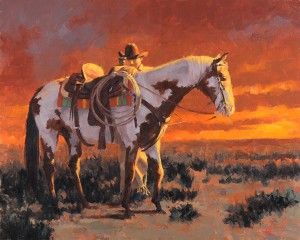
Jim Connelly, Sunset, oil, 16 x 20.
As with countless mid-20th-century American children, the western lore of the cowboy was embedded in Connelly’s imagination as a boy. For an outdoorsy kid who loved horses and was good with his hands, ranch work held the aura of an ideal job. In his romanticized vision it was symbolized by freedom and satisfied days in the saddle under a vast western sky. “Given a chance, I think it’s really something I could have done,” he muses. “I’ve always been drawn to western themes.” Those themes were not a big part of his commercial work, but when the illustration field began shifting inexorably toward computers and away from hand-rendered imagery, Connelly was ready to shift as well. He pored over copies of Southwest Art. In the paintings of James Reynolds and other master western artists, he found the combination of subject and style that linked his lifelong passions and inspired him toward a more impressionistic approach. Just as he had some years earlier, he once again re-envisioned the focus of his work, believing that what he put his mind to, he could do. “I asked myself: How do you want to paint? I started going in that direction,” he recalls, referring to the cowboy art he loved. “And everything came together.”
Jim Connelly, Calm Before the Storm, oil, 18 x 24.
Connelly’s faith and his home base in the Midwest both strongly influence his approach to cowboy art.
IN 2001, Connelly made his second-ever trip to the West—his first had been to Oklahoma when he was 21—taking part in a workshop with acclaimed painter Kim English at a Colorado ranch. There, in the swirling dust of corrals, amid the smell of leather and horses and the camaraderie of working cowhands, the visual world of his chosen subject came to life. Returning to Michigan with hundreds of photographs, he began working in the evocative style and genre for which he has become known. For inspiration and source material, the artist often travels to a large guest ranch in western Michigan and to rodeos at fairs around the state. At one of these, a line of young cowboys in the bull-riding competition was waiting to be introduced. From that image came THE USUAL SUSPECTS, which plays on the young men’s body language and the angles of their hats. “They were standing there snickering at each other,” Connelly relates. “When a group of guys are all into the same thing like that, each one’s personality and character comes out.”
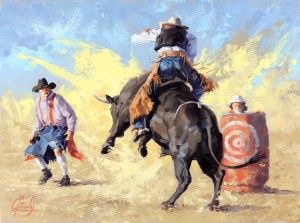
Jim Connelly, Backyard Bully, oil, 12 x 16.
Capturing the wild excitement, intense action, and danger of bull or bronc riding is another matter. To ignite his paintings with a visceral sense of that short-lived thrill, Connelly employs dynamic brush strokes and fiery colors to invoke an eruption of movement and kicked-up dust. BLAZING SADDLE, for example, focuses on the rider in an explosion of color, while cowboy spectators recede in an abstracted background of darker hues. “It’s a lot of fun, but it’s challenging,” he says of the process. “It looks like just splattering paint, and that’s how it’s supposed to look. But something abstracted can be as hard as painting tight.” By contrast, when he finished CALM BEFORE THE STORM, Connelly wondered if something was wrong with the piece. “Then I realized it was the calmest thing I’d ever painted,” he relates with a grin. “What’s really interesting to me is how calm the animals are before the cowboy gets on and the chute is opened. At that moment, everything is fine.” With photos on hand of the same pair in action, the artist plans to also paint the raging storm of animal, rider, and dust that, a few seconds later, would thunder out of the chute.
Connelly’s faith and his home base in the Midwest both strongly influence his approach to cowboy art. Not having spent endless hours in the saddle and years in the down-and-dusty world of working cattle, he still holds more than a trace of the idealism he had as a boy. “To me, it’s sort of a fantasy,” he acknowledges. “I have no bad experiences to bring to it. Some people seem to think that if you don’t paint the dark side, it’s not realistic. But I’d rather bring out the best of it, the beauty of it.” In fact, he says, visually expressing the positive, uplifting elements in life is central to his underlying spiritual view: “There’s beauty in creation. There’s almost a moral value in that beauty, and painting something beautiful is a good thing in itself.”
representation
Dana Gallery, Missoula, MT; Capital Fine Art, Austin, TX; Turpin Gallery, Jackson, WY; Open Range Gallery, Scottsdale, AZ; www.jimconnellystudio.com.
Featured in the March 2013 issue of Southwest Art magazine–click below to purchase:
Southwest Art March 2013 digital download
Southwest Art March 2013 print issue
Or subscribe to Southwest Art and never miss a story!
- Jim Connelly, White Lighting, oil, 18 x 24.
- Jim Connelly, Usual Suspects, oil, 12 x 24.
- Jim Connelly, The Prodigal, oil, 12 x 16.
- Jim Connelly, Tantrum, oil, 11 x 14.
- Jim Connelly, Sunset, oil, 16 x 20.
- Jim Connelly, Summer Sunset, oil, 9 x 12.
- Jim Connelly, Shootin’ the Breeze, oil, 12 x 16.
- Jim Connelly, First Snow, oil, 16 x 20.
- Jim Connelly, Calm Before the Storm, oil, 18 x 24.
- Jim Connelly, Breakfast of Champions, oil, 16 x 20.
- Jim Connelly, Blazing Saddle, oil, 16 x 20.
- Jim Connelly, Backyard Bully, oil, 12 x 16.
MORE RESOURCES FOR ART COLLECTORS & ENTHUSIASTS
• Subscribe to Southwest Art magazine
• Learn how to paint & how to draw with downloads, books, videos & more from North Light Shop
• Sign up for your Southwest Art email newsletter & download a FREE ebook






